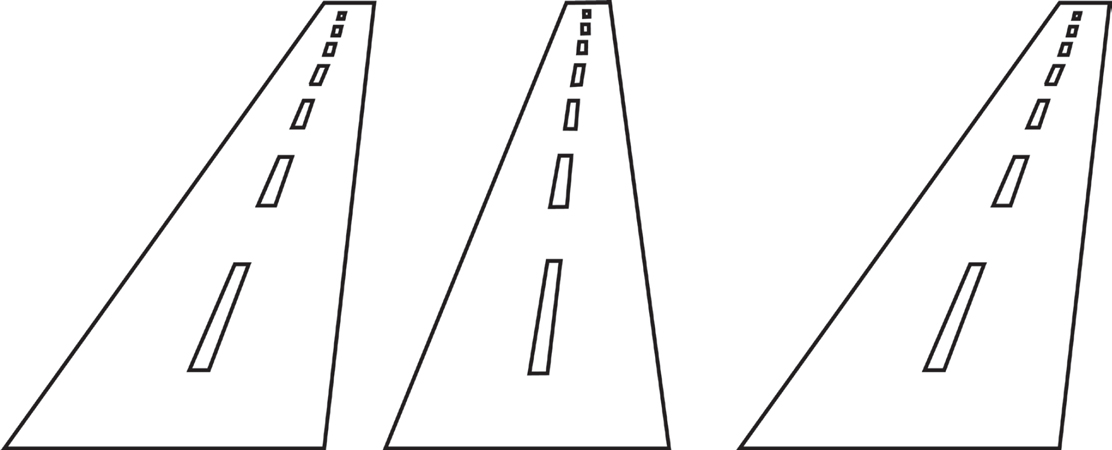
PERSPECTIVE AND DEPTH ILLUSIONS
Your perspective on the world dictates how you see objects. When visual targets are far away from you, they project images on your retinas that are smaller than the images projected by objects that are nearby. So when an object’s retinal image shrinks, your brain assumes that the smaller image corresponds to a greater intervening expanse between you and the object. The same geometry explains why parallel lines—such as train tracks—appear to converge as they recede. That’s just one way your visual system uses your viewpoint to help construct your perception of 3-D objects. We say “construct” because the visual system has no direct access to 3-D information in the world. Your perception of depth integrates many cues in addition to perspective, including stereopsis (our left and right eyes receive horizontally displaced images of the same object; our brain uses this “horizontal disparity” as a main mechanism behind our perception of depth), occlusion (objects near us occlude, or block, objects farther away), chiaroscuro (the contrast of an object as a function of the position of the light source), and sfumato (the feeling of depth produced by the interplay of in- and out-of-focus elements in an image, as well as from how transparent or opaque the atmosphere is). By combining these indicators, your brain forms an object’s shape in 3-D space.
BY FREDERICK KINGDOM, ALI YOONESSI, AND ELENA GHEORGHIU
McGILL UNIVERSITY, CANADA
2007 FIRST PRIZE

How could we have missed it? Hundreds, perhaps thousands, of visual scientists, psychologists, neuroscientists, artists, architects, engineers, and biologists all missed it—until 2007. The “it” in question is the Leaning Tower Illusion, discovered by Frederick Kingdom, Ali Yoonessi, and Elena Gheorghiu. In this illusion, two identical side-by-side images of the same tilted and receding object appear to be leaning at two different angles. This amazing effect was first noticed in images of the famed Leaning Tower of Pisa, but it also works with paired images of other receding objects. Though the Leaning Tower Illusion is one of the simplest visual tricks, it is also one of the most profound for what it adds to our understanding of depth perception. This is why vision scientists still shake their heads in disbelief that they did not notice the illusion earlier. Kingdom and his colleagues introduced the illusion at the 2007 Best Illusion of the Year Contest, where it won first prize.


On the opposite page, the tower on the right appears to lean more than the tower on the left—but these two photographs of the Leaning Tower of Pisa are duplicates. Because the two Pisa towers pictured in the paired images do not converge as they recede, as they would if standing side by side in front of our eyes, the brain mistakenly perceives them as diverging. In contrast, when we look at a single photograph showing two actual parallel towers, such as the Petronas Twin Towers in Kuala Lumpur, we see the buildings converge in the distance as they recede, and therefore we perceive them as parallel.
Further analysis of similar images indicates that the phenomenon applies to all sorts of receding objects, not only those that recede in height. It is hard to believe, but these are actually identical images of parallel train tracks. Although the angles of the train tracks are the same in both images, the brain perceives them as being quite different.

The Leaning Tower Illusion is so central to our visual system that it works even with simple depictions of 3-D objects receding into the distance. The parallel lines corresponding to the long edges of the checkered box on the right seem to diverge; that is, the box appears wider at the back than it does at the front, though in fact the back and front are precisely the same width.
The Leaning Tower Illusion does not occur when we view two leaning Japanese manga girls, even though the two cartoon images are tilted. The reason is that the cartoon girls do not appear to recede in depth, so our brain does not expect them to converge in the distance. This phenomenon demonstrates that the brain applies its depth-perception toolkit only in specific situations, depending on the object.

BY KIMBERLEY ORSTEN AND JAMES POMERANTZ
RICE UNIVERSITY, U.S.A.
2014 THIRD PRIZE
In 2014, Orsten and Pomerantz used the principles underlying the Leaning Tower Illusion to show that two different images can look identical (scientists call these metamers), and that, conversely, two images that are physically the same can look different (anti-metamers). Of the three images below, which is the odd man out? It’s probably not your first guess. Orsten and Pomerantz explained that our visual system usually does a good job when interpreting true 3-D objects, but has difficulty interpreting 2-D representations of 3-D objects such as drawings.

The left and central roads look the same. In reality, the left and right roads are identical, and the central road is different.
BY VICTORIA SKYE, U.S.A.
2014 FINALIST
The magician, photographer, and illusion creator Victoria Skye was having a hard time taking a picture of a photo portrait of her father as a teen. The strong overhead lighting was ruining the shot, so she tilted the camera to avoid the glare, first one way and then the other. As she moved her camera back and forth, she saw her father morph from teen to boy and then to adult.
Skye’s illusion is an example of anamorphic perspective. By tilting her camera, she created two opposite vanishing points, producing the illusion of age progression and regression. In the case of age progression, the top of the head narrows and the bottom half of the face expands, creating a stronger chin and a more mature look. In the case of age regression, the opposite happens: the forehead expands and the chin narrows, producing a childlike appearance.
Skye thinks that her illusion may explain why, when we look at ourselves in the mirror, we sometimes see our parents, but not always. “I wonder if that is what happens to me when I look in the mirror and see my mom. Do I see her because I tilt my head and age myself just as I did with the camera and my dad?” she asked.
ARASH AFRAZ AND KEN NAKAYAMA
MASSACHUSETTS INSTITUTE OF TECHNOLOGY AND HARVARD UNIVERSITY, U.S.A.
2013 THIRD PRIZE
Do you have any idea how hard it is for an Iranian national to rent a small plane for the purpose of “taking pictures” of skyscrapers in Boston? Arash Afraz, a researcher at MIT, and two of his Iranian friends found out the hard way—faster than you can say “post-9/11 Guantánamo strip search”—to bring us this amazing illusion. Afraz, working with Ken Nakayama of Harvard University, developed an unconventional method of creating stereoscopic anaglyph photographs, also called 3-D photographs, on a massive scale, bagging the third prize in 2013.
We perceive most everyday objects as 3-D structures because the separation between our eyes produces very different images on our two retinas. For small-to-medium-sized objects, our visual system uses this ocular disparity to produce stereovision. But very big, faraway objects, such as a city skyline, generate identical images on both eyes, and we do not experience stereoscopic perception. Until now. Afraz and Nakayama’s images allow us to see a full city in stereovision. To create this illusion, Afraz snapped pairs of large-scale photo shots, hundreds of meters apart, from his airplane. That’s about three thousand times larger than the distance between your eyes. The result offers a glimpse of how Boston’s cityscape would look through the eyes of a giant who perceived the skyline stereoscopically. View the image below while wearing red/cyan anaglyph 3-D glasses and you’ll see Boston from just such a perspective. The buildings and other city-scale objects will appear miniaturized, as if in a detailed toy-set model. This is because our natural stereovision occurs only when we view relatively small objects. Seeing a huge object in stereo creates the illusory perception that the object is a miniature. Afraz and Nakayama’s illusion shows that visual perception does not derive passively from physical parameters such as the horizontal disparity between two images, but is instead an active interpretation of the external world, based on both sensory evidence and prior assumptions.

STEREO VISION PRODUCES NEW ILLUSORY CONTOURS!
DAVI GEIGER AND HIROSHI ISHIKAWA
NEW YORK UNIVERSITY, U.S.A., AND NAGOYA CITY UNIVERSITY, JAPAN
2009 FINALIST
Our visual system fills in all sorts of perceptual gaps. In the central image below, a white hexagon appears between the stars, even though its edges are incomplete; our brain sees past the broken lines to discern the shape. This type of neural shortcut is critical to shape perception in a noisy visual world. Geiger and Ishikawa’s illusion shows that our visual system can use stereoscopic information gleaned from the two eyes’ inputs to enhance our discernment of the shape of an illusory object—or, in this case, objects! With the help of stereoscopic visual cues, our brains can sense illusory shapes that don’t exist on a single plane. To try it, you will need either to cross or to uncross your eyes, so that two of the three images slide over each other and fuse into a single image. You can either diverge or converge your eyes to combine the left and central images or the central and right images (whichever is easier for you). The perceptual outcome will be the same in both cases: two illusory triangles (one pointing down, one pointing up) formed on two different stereoscopic depth planes. Notice that the two triangles don’t exist in either image when viewed without stereoscopic convergence.

HIDDEN STRENGTH OF THE CLASSICAL SIMULTANEOUS CONTRAST ILLUSION
PAWAN SINHA
MASSACHUSETTS INSTITUTE OF TECHNOLOGY, U.S.A.
2006 FINALIST
Simultaneous contrast is an illusory effect demonstrating that the perceived brightness of an object is relative to its surroundings. See the small central rectangle in the left-hand image below, representing the classical simultaneous contrast illusion. You may sense that the rectangle’s left side is lighter than its right side. This occurs because your brain calculates brightness as a function of the surrounding context.
But now consider the two small gray squares in the right-hand image below. They are also the same shade of gray, but they look much more different in apparent brightness. Sinha realized that if you bring the two gray squares right next to each other by crossing your eyes and aligning the left and right colored dots with their corresponding counterparts, the two gray halves of the resulting rectangle remain strongly dissimilar, even though now they have the same visual proximity as in the classic simultaneous contrast illusion. One possible explanation is that the brain circuits that calculate brightness do not work across the two eyes.
